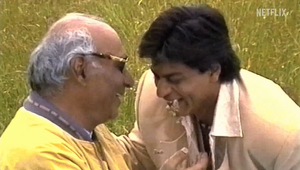
Giving Life to the Foo Fighters’ Shame

World-renowned photographer Paola Kudacki first met Dave Grohl in 2008 when she photographed him for the cover of GQ. As Led Zeppelin played overhead, Kudacki and Grohl connected over the playlist. Sharing a love for this music, Kudacki and Grohl related to one another how dark sounds can evoke such strong feelings that it’s actually empowering. Both recognised that feeling those deep emotions captivates you.
A 13-year (and counting) friendship emerged and we fast forward to MTV Video Music Awards 2021, where Kudacki, Grohl and the band recently enjoyed a special evening at Brooklyn’s Barclay Center celebrating the Foo Fighters Icon Award and their three VMA nominations (Best Rock Video, Best Choreography, and Best Cinematography) for “Shame Shame” directed by Kudacki.
Today marks the one year anniversary of the music video hitting our screens and we felt now was the perfect time to explore with Kudacki how the film and ‘Shame’ came to life.
Inspired by a dream Grohl had as a teenager, the film opens on Grohl alone on a forlorn landscape, dragging his battered guitar and struggling to get up a hill to a coffin beneath a lifeless tree.
Inviting audiences into the enigma of a dream – the almost-truthful, tangible yet intangible elements – Kudacki shot the entire landscape using practical elements inside the studio with real grass, real fog, real fire, and sky projections shot in-camera to create the duality of a real versus surreal experience.
“Not only did we want to create this dream experience, we wanted to work into the psychology of shame and explore the complex vulnerabilities of this emotion,” shares Kudacki. “Through this, shame became a character for which we cast actor and dancer Sofia Boutella.”
Shame (Boutella) makes her entrance as a mysterious pair of hands crawling around Grohl’s face. This begins the journey of an all-consuming figure, a relationship that reflects how shame is both alluring and destructive — and one that Grohl is paralysed by rather than charmed. “Shame is an emotion that comes without invitation and is most often met with resistance and we wanted to set up a chorographical representation of this experience,” adds Kudacki.
To help the talent embody a tense and trapped feeling while filming, Kudacki kept the set silent, impeding the fluidity of movement and any rhythm a music video set might normally have flowing among the talent and the crew. The only exception to this rule was when Grohl and Boutella had to sync with the chorus. “When the chorus finally played and Dave and Sofia began to sing – both broke into tears as the words connected to this constrained state they were holding themselves to,” notes Kudacki. “We had this authentic moment where the effects of that state had to erupt.”

When Grohl finally reaches the top of the hill, the coffin is on fire. Grohl and Boutella face one another and she decides to let him go. Her work is done – yet, in the dualistic reality of this – Shame was him, it was never a separate force or creature. He’s ultimately led himself to this point.
“I think seeing ‘shame’ in a physical manifestation helps people relate to this powerful emotion in a poetic way and how those feelings become experiences,” says Kudacki. “Your action or in-action, how your mind can feel controlled by thoughts or a vivid dream and they act as a physical restraint over you.”
At the end of the film, Grohl, alone again, crosses his threshold for suffering, surrendering to shame’s course and digs his own grave. Grohl falls into the grave which becomes a black void and eventually water. Is it the end? Is it a rebirth? Is it the circle of life? These are questions that we have to answer for ourselves.















